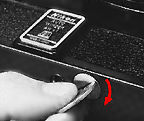Mounting a Lens
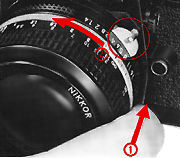 |
|
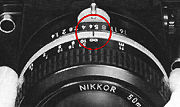 |
 |
In lenses having no slotted prong, mounting is done at a position where its aperture indicator aligns with the coupling pin of the camera. |
Maximum aperture indicator
The ELW was not an AI (Automatic maximum aperture Indexing) camera yet but has an improved (Semi-automatic) way to providing a maximum aperture metering. In order to measure light at full aperture with lenses of different maximum apertures, the Nikkormat ELW's meter must be adjusted for the maximum aperture of the lens in use. This must be done each time a lens is mounted. Turn the aperture ring all the way to the minimum aperture setting (largest f/number), then all the way in the opposite direction. This step automatically adjusts the meter to the maximum aperture of the lens. A year later in 1977, the Nikon EL-2 with a 'newly' introduced AI feature were introduced along with 4 other models, the professional F2A, F2AS and mechanical counter part of the EL2, the Nikkormat FT3 (replacing the non-AI FT-2 and FTn) and also saw the debut of compact sized Nikon FM. With the AI version models, you don't have to perform and set the maximum aperture of the lens in use on the camera body as with the ELW here.
 |
Maximum aperture scale |
Removing the Lens
To remove the lens from the camera, press the lens-release button (1) and twist the lens to the right as far as it will go . The lens will come loose and can be lifted out. (Make sure the lens aperture is set to f5.6 prior to mount the meter coupling shoe to the meter coupling pin (2).
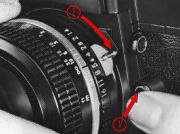 |
* Avoid and do not try to remount the lens while in the process of removal. The slotted prong of the lens must be disconnected from the coupling pin of the camera once, and the coupling pin turned to the right as far as it will go, before the lens can be remounted. |
ATTACHING & REMOVING THE NIKON AUTO WINDER AW-1
To attach the AW-1
Align the spindle of the
coupling portion of the Auto Winder AW-1 with the slot of the coupling portion on
the bottom of the ELW, and turn the camera attaching screw of the AW-1 clockwise
with a coin, and tighten securely. For details consult the manual for the AW-1.
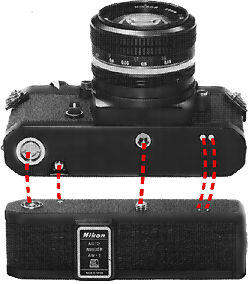 |
|
To remove the AW-1
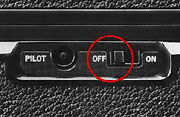 |
Before removing the Auto Winder AW-1, be sure to turn the power switch off first. Then, remove the AW-1 from the camera by turning the camera attaching screw counterclockwise. Check the main reference map of the AW-1 for respective position of its various control, levers and buttons. |
| Previous | Main Features and Battery Issues
| Next | Preparing your camera, setting ASA and frame counter (3/8)
Back to Main Index Page of Nikkormat EL-W
| Back | to Main Index Page of Nikkormats EL Series
| Back | to Main Index Page of Nikkormats
History & Background of Nikkormat Cameras
"Nikomat" Picture Library of Japanese local version
Outline the major key features and differences of various models
The Camera Bodies | FT | FS | FTn | EL | FT2 | ELW | FT3 | EL2
| Main Reference
Map
|
HTML Format: FT | FS | FTn | EL | FT2 | ELW | FT3 | EL2 | AW-1 Motor Winder
PDF Format: FT
| FS | FTn | EL | FT2 | ELW | FT3 | EL2 | AW-1 Motor Winder
| Specifications |
FT
| FS | FTn | EL | FT2 | ELW | FT3 | EL2
| Message Board | for
your favourite Nikkormats
| Message Board | for your Nikon Optics
in a shared environment
| Message Board | Specifically for Dispose or Looking for Nikon/Nikkor Photographic
Equipment
 |
The Eyes of Nikon:- |
Fisheye-Nikkor Lenses - Circular | Full Frame | Ultrawides Lenses - 13mm15mm18mm20mm | Wideangle Lenses - 24mm28mm35mm |
Standard Lenses - 45mm 50mm 58mm | Telephoto Lenses - 85mm105mm135mm180mm & 200mm |
Super-Telephoto Lenses - 300mm 400mm 500mm 600mm 800mm 1200mm |
Special Application lenses:
Micro-Nikkor Lenses - 50mm~55mm -60mm 85mm -105mm 200mm Micro-Zoom 70-180mm
Perspective Control (PC) - 28mm 35mm PC-Micro 85mm
Dedicated Lenses for Nikon F3AF: AF 80mm f/2.8 | AF 200mm f/3.5 EDIF
Depth of Field Control (DC): 105mm 135mm
Medical Nikkor: 120mm 200mm
Reflex-Nikkor Lenses - 500mm 1000mm 2000mm
Others: Noct Nikkor | OP-Nikkor | UV Nikkor 55mm 105mm | Focusing Units | Bellows-Nikkor 105mm 135mm
Nikon Series E Lenses: 28mm35mm50mm100mm135mm | E-Series Zoom lenses: 36~72mm75~150mm70~210mm
MF Zoom-Nikkor Lenses: 25~50mm | 28~45mm | 28~50mm | 28~85mm | 35~70mm | 36~72mm E | 35~85mm | 35~105mm | 35~135mm |
35~200mm | 43~86mm | 50~135mm | 50~300mm | 70~210mm E | 75~150mm E | 80~200mm | 85~250mm |
100~300mm | 180~600mm | 200~400mm | 200~600mm | 360~1200mm | 1200~1700mm
Tele-Converters: TC-1 | TC-2 | TC-200 | TC-201 | TC-300 | TC-301 | TC-14 | TC-14A | TC-14B | TC-14C | TC-14E | TC-16 | TC-16A | TC-20E
![]()
Nikon F
| Nikon F2 |
Nikon
F3
| Nikon F4 |
Nikon
F5
| Nikon F6 |
Nikkormat / Nikomat |
Nikon FM
| Nikon FE/ FA | Nikon EM/FG/FG20 | Nikon Digital SLRs | Nikon - Other models
MIR Supports for Photographic Community: Various Message Boards/Community
Forums
Nikon
F-series|
Nikon
F2-series|
Nikon
F3-series|
Nikon F4-series| Nikon
F5-series|Nikkormat/Nikomat-series
Nikon FM-series|Nikon
FE-series|Nikon
FA|Nikon
Digital
SLR
series|Various
Nikon
Models|Nikkor
Optic
-shared
Others:- Free Trade Zone - Photography| Free Trade Zone - Business Community |Free To Zouk - Photographic Community
Apple's Mac Public Community Message Board | Windows based PC &
Apple/Mac
Public Community Trade Exchange Centre
Recommended links to understand
more technical details related to the Nikkor F-mount and production Serial Number:
http://rick_oleson.tripod.com/index-153.html by: my friend, Rick Oleson
http://www.zi.ku.dk/personal/lhhansen/photo/fmount.htm by: Hansen, Lars Holst
http://www.mir.com.my/rb/photography/hardwares/nikonfmount/lens2.htm
http://www.photosynthesis.co.nz/nikon/serialno.html
About
this photographic
site.
Home - Photography
In Malaysia
![]()
Copyright
© 1998.
HIURA Shinsaku ® ; Nikomat ML, Japan,
in collaboration with leofoo ®. MIR Web Development Team.
* Credit: A
Great thanks to Mr Denis Pleic for his volunteering
effort to reedit content and and patching some grammatical mistakes found in this
section of the PIM site. Miss
Rissa (Marketing) & Edward
(Techical) of Shriro Malaysia, distributor of Nikon cameras in Malaysia, in providing
so many useful inputs to make this site possible. Mr Hong,
Ipoh for lending me his FT2 to take some of the images used in this site. This site
is created for his eldest son, Yuen who has picked up his father's hobby and
the FT-2. My friend, John Walls from Florida, US for his images of the FTn
body and the Zoom Nikkor
43-86mm.
[Left Brain][Right brain][Home-MIR] [Invention][Art & Design][Clubs]
[Portfolios][On assignments] [Trading room][Knowledge & Resources] [Free-trade-zone][Thoughts & opinions][Links]
